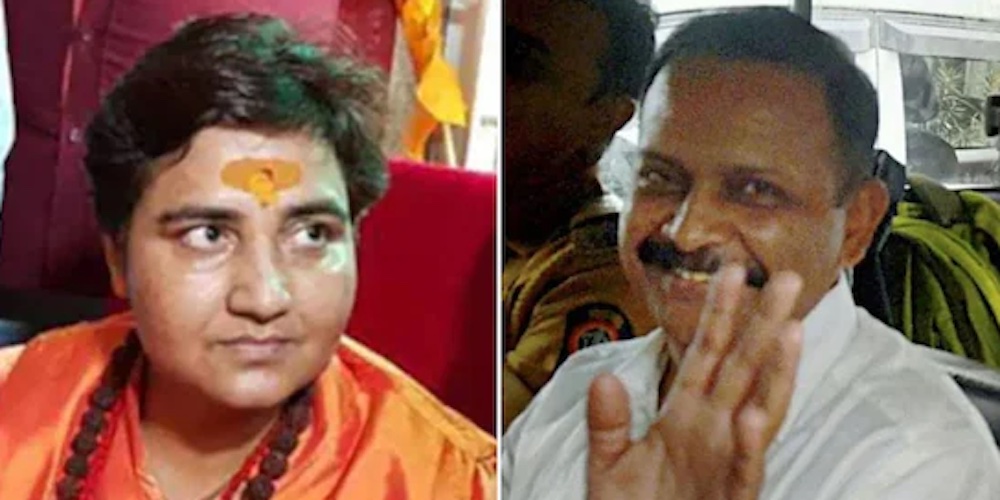RIGHT ANGLE – Hindu Terror: Greatest Shame of the Congress

I think the Bharatiya Janata Party represents countless Indians by demanding that the Congress party, particularly the Gandhi family, former Home Minister P Chadambaram and former Madhya Pradesh Chief Minister Digvijay, must apologize to the nation for manufacturing and trying to popularise the narrative of Hindu/saffron terrorism when they were in power in between 2004 and 2014.
Anybody believing in justice knew that persons the then UPA government, headed by late Manmohan Singh but led in reality by Sonia Gandhi, accused of being “Hindu terrorists” would get relief by the judiciary. And that is what exactly happened when on July 31, the Special NIA court acquitted all the seven, including the proud Army officer LT.Colonel Prasad Purohit and former M.P. Pragya Singh Thakur, in the 2008 Malegaon blast case.
Of course, Col. Purohit and Thakur had been on bail since 2017 , thanks to the Supreme Court of India, as they were incarcerated in prison without chargesheets for as long as seven years, during which they were physically abused by the interrogators. The apex court had also observed that there was “considerable doubt” about their involvement in Malegaon blasts. In fact, the Supreme Court had directed that their bail plea should be examined by a special trial court.
It is also worth noting that on its part, the Indian Army had conducted its Court of Inquiry and some 50 witnesses, officers and men had given their testimony in favour of Purohit. They had hailed Purohit as a dedicated professional who had infiltrated organisations like SIMI and the Indian Mujahideen and some right-wing outfits like Abhinav Bharat, “with full knowledge and concurrence of his seniors.”
The Malegaon bombings were a series of bomb blasts that took place on 8 September, 2006. The Maharashtra police initially suspected Bajrang Dal, the Lashkar-e-Toiba(LeT) or the Jaish-e-Mohammed of involvement in the attacks. Investigators then said that the explosives contained in these bombings were “a cocktail of RDX, ammonium nitrate and fuel oil — the same mixture used in 7/11”, referring to the 11 July 2006 Mumbai train bombings. In fact, on that basis, the Anti Terrorist Squad (ATS) of Maharashtra prima facie ruled out the involvement of Hindu Nationalist groups like the Bajrang Dal in the Malegaon blasts; it cited two reasons: one, RDX is only available to Islamist outfits; two, Bajrang Dal activists so far had only used crude bombs, nothing as sophisticated as the ones in Malegaon.
Accordingly, the Police arrested members of the Students Islamic Movement of India and their promoters. In fact, on 28 November, 2006, the Mumbai police stated that two Pakistani nationals were involved in the explosions. “We have successfully detected the Malegaon blasts case. We are, however, on the lookout for eight more suspects in the case,” said DGP PS Pasricha.
However, the contours of the investigation by the ATS underwent radical changes once Hemant Karkare succeeded KP Raghuvanshi as its chief in January 2008 (eventually he was succeeded by Raghuvanshi after he was killed during the attack in Mumbai on 26 November, 2008). It is an open secret that Karkare had excellent relations with senior Congress leaders, particularly Digvijay Singh. Karkare started the process of highlighting “saffron terror” with the arrest of Purohit and Sadhvi.
Incidentally, the theory of “saffron terror” was popularised by the UPA regime to neutralise the adverse impacts of the 26/11 tragedy (attack on Mumbai in 2008), particularly during the electioneering for the 2009 general elections. This strategy went into full swing soon after the Congress party won the 2009 general elections and the assembly elections in Rajasthan and Haryana. At the time, not only at the Centre but also in Rajasthan, Haryana, Andhra Pradesh and Maharashtra there were Congress governments. “Re-investigations” of previous terrorist incidents such as the blasts in Samjhauta Express, Malegaon, Ajmer Sharif and Mecca Masjid (Hyderabad) were reopened simultaneously to implicate “Hindu terrorists”.
We all know how as the Home Minister Chidambaram had changed in 2009 the original affidavit describing Ishrat Jahan, killed in a police encounter in June 2004, a member of a Pakistan-based Lashkar module. He said “there was no conclusive evidence” against Ishrat. Incidentally, she and her three other friends were killed by Gujarat Police in June 2004 in an encounter based on feedback from the Jammu and Kashmir Police. It was said that the group was plotting to kill the then Gujarat Chief Minister Narendra Modi.
In July 2004, Lashkar-e-Taiba (LeT) had published an article on the Jamaat-ud-Dawah’s website claiming Ishrat Jahan as their operative. But around this time, the Congress-led UPA assumed office. The Congress as well as many human rights activists saw the incident not as a conspiracy to kill a Chief Minister but as “a fake encounter”, emphasising the point that in a democratic country, a criminal should be punished by the judiciary alone, not the police. As the controversy grew, the LeT issued a clarification in 2007 (after three years) saying that it was wrong in naming Ishrat as its activist in India!
It was against this background that Chidambaram changed the affidavit. That Chidambaram was wrong became evident when David Headley, who conspired with the LeT in plotting the 26 November, 2008 (26/11) Mumbai attacks, admitted, first to the American Federal Bureau of Investigation and then before an Indian court, that Ishrat Jahan was indeed a “fidayeen” (sacrificial aspirant) working for someone named Muzammil Bhat or Muzammil Butt of the LeT to target Modi.
Incidentally, the narrative of saffron terrorism , fully manifested 2008 onwards, was necessitated for the Congress party not only to neutralise the adverse impacts of the 26/11 tragedy but also to revive normal interactions with Pakistan.

It would seem that but for the capture of Pakistani terrorist Kasab alive during the 26/11 attacks, the Congress party would have termed the incident as an act of “saffron terror”. In fact, in 2010, the internet whistleblower organisation WikiLeaks released US embassy cables in which the then US ambassador to India was told by a senior Indian minister that the death of Hemant Karkare, a senior anti-terrorism investigator killed during the 2008 Mumbai attacks, was somehow orchestrated by Hindu extremists just because he was fighting ‘saffron terror’.
Coincidentally, this was the time when none other than Rahul Gandhi told American diplomats, as WikiLeaks revealed, that the real danger to India came from the “Hindu terror”. And importantly this strategy went in full swing soon after the Congress party won 2009 – Assembly elections in Rajasthan and Haryana. At the time, not only at the Centre but also in Rajasthan, Haryana, Andhra Pradesh and Maharashtra there were Congress governments.
“Reinvestigations” of the aforementioned terrorist incidents, all occurring in these four states, and implicating “the Hindu terrorists” for these incidents (earlier all those arrested accused in these cases happened to be members of the banned Muslim organisations like SIMI), and then linking it with the Ishrat Jahan case, became very easy. It all began with Samjhauta blasts. For those uninitiated, a terrorist attack occurred around midnight on 18 February, 2007, on the Samjhauta Express, a twice-weekly train service connecting Delhi and Lahore. Bombs were set off in two carriages, both filled with passengers, just after the train passed Diwana station near Panipat. 68 people were killed in the ensuing fire and dozens more injured. The attack came just a day before the then Pakistani Foreign Minister Khurshid Mahmud Kasuri was to arrive in New Delhi to resume peace talks with Indian leaders.
Initial investigations suggested that the prime suspects in the bombing were the LeT and JeM (another outfit in Pakistan), both whom have been blamed for many high-profile bombings in the past. Importantly, on 1 July, 2009, the United States Treasury and United Nations Security Council placed sanctions on LeT and named one Arif Qasmani as having played a role in the bombing. But surprisingly, all of a sudden in 2008 Police Officer Hemant Karkare, who was heading the Maharashtra Anti-Terrorism Squad (ATS), came up with a theory that one Lt Col Prasad Purohit supplied the RDX that was used in the Samjhauta Express blast. Purohit, according to him, was a prominent member of the “Hindu terror outfit” Abhinav Bharat.
Subsequently, the National Investigation Agency (NIA), which the Manmohan Singh government had specially created soon after the 26/11 attacks to act as the Central Counter Terrorism Law Enforcement Agency, filed a chargesheet against five accused — Naba Kumar Sarkar alias Swami Aseemanand, Sunil Joshi (now dead), Lokesh Sharma, Sandeep Dange alias Parmanand and Ramchandra Kalasangra alias Ramji alias Vishnu Patel — in the Samjhauta Express blasts case at a special court in Panchkula. The timing was important as it was done just on the eve of the foreign secretary Nirupama Rao’s visit to Pakistan to talk to her counterpart there and prepare grounds for the much anticipated parleys between the foreign ministers of the two countries. Indo-Pak talks had not gathered the required pace in the absence of Pakistan’s co-operation in punishing those responsible for attacks on Mumbai on 26 November, 2008.
By chargesheeting the alleged “Hindu terrorists” on the eve of Rao’s visit, the Manmohan Singh government allowed Pakistan to project a linkage between the two incidents. As veteran security expert late B Raman argued then, the Manmohan Singh government virtually walked into the Pakistani trap by relaxing the pressure on Islamabad to arrest and prosecute successfully all those involved in the 26/11 strikes and by succumbing to its pressure on the Samjhauta Express incident.
As already pointed out, the theory of “saffron terror” was evolved to neutralise the adverse impacts of the 26/11 tragedy, particularly during the electioneering for 2009 general elections. Once evolved, there were logical follow-up measures, one of which also included a proposed Bill to combat communal violence that projected Hindus as inherently communal and therefore it was they who would be proving their innocence if charged, not the other way round, as mandated by any normal jurisprudence. That it was not pursued because of the vociferous protests by the likes of late Arun Jaitely in Parliament is a different matter, though it definitely would have become the country’s law had the Congress retained power in 2014-elections.
In retrospect, one finds this anti-Hindu mindset of the UPA government very surprising, given the fact that despite their overwhelming majority and despite the cruel history that the community has experienced, the Hindus had no problem with having a non-Hindu Prime Minister and a non-Hindu as the chief of the country’s largest political party. In fact, when Singh became Prime Minister the first time (2004), he was administered oath by a non-Hindu (Muslim) President of the country as well. If anything, this proves the intrinsic secular character of the Hindus.
Regretably,because of its vote-bank politics and pursuit to appease the Muslims at any cost, the Congress continues to find virtues in the theory of Hindu-terrorism. Otherwise, Chadambaram would not have said last week without any sense of guilt or shame that three terrorists who killed the innocent tourists in April at Pahelgam just because they were Hindus were not Pakistanis and could have been insiders. That three days after he doubted the gory incident to be the handiwork of the Hindus terrorists, all the three were killed by our brave security personnel and they turned out to be the Pakistanis and hardcore LeT members.
Shame, Mr. Chidambaram, that you were India’s Home Minister ! And shame that the Gandhi family, of which Chidambaram is a loyal “sevak”, has made the once great Congress party a fiefdom dedicated to demonising Hindus.


